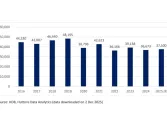
Luxury market growth expected to slow in 2025
Key concerns include weaker demand from major consumer markets.
The luxury goods industry, which typically grows around 7% annually, faces a slowdown in 2025, according to Morgan Stanley.
Rising macroeconomic pressures, limited pricing power, and weak demand from key markets are driving the downturn.
Luxury brands saw sales surge over 80% between 2019 and 2024, fuelled by post-COVID savings, U.S. stimulus, and new consumers. However, the current market conditions present a more uncertain future.
Key concerns include weaker demand from major consumer markets—China, the U.S., and Europe—which together account for 75% of the industry's spending.
Additionally, the sector is facing the normalisation of growth after the pandemic, the impact of U.S. tariffs, high interest rates in Western countries, and broader expectations of slower global economic growth.
“We are in a very different environment today. Luxury pricing power has eroded after significant post-pandemic price increases, and Chinese demand will remain flat at best this year,” said Edouard Aubin, Morgan Stanley’s Head of European Luxury Brands Research. “The consensus view is that the industry is in no position to pass on meaningful price increases.”
“Luxury pricing power has eroded, and Chinese demand will stay flat at best,” said Edouard Aubin, Morgan Stanley’s Head of European Luxury Brands Research. “The industry can no longer pass on significant price increases.”
Chinese consumers, the biggest spenders in luxury, have cut back sharply. A Morgan Stanley AlphaWise survey of over 2,000 Chinese consumers in April found 60% plan to reduce spending over the next six months, citing job and income concerns following new U.S. tariffs.
The report noted that US consumers are not likely to fill the gap. Hopes for a 2025 rebound are fading after only a temporary bump in April, driven by seasonality, pent-up demand, and tariff-driven buying.
Whilst many companies dodged tariff impacts by shipping early, Morgan Stanley said the bigger risk is a recession and falling consumer confidence.
Short-term demand is expected to stay soft. A recovery could come if US markets keep climbing or China’s real estate sector stabilises.

















 Advertise
Advertise





